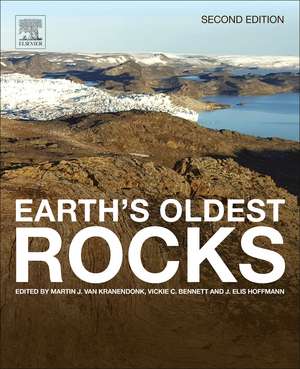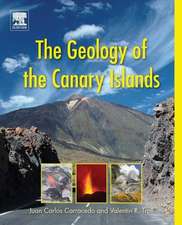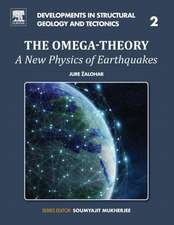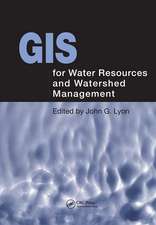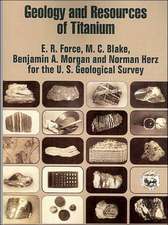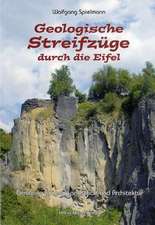Earth's Oldest Rocks
Editat de Martin J. Van Kranendonk, Vickie Bennett, Elis Hoffmannen Limba Engleză Paperback – 27 sep 2018
The research in this reference concentrates on what is directly gleaned from the existing rock record to understand how our planet formed and evolved during the planetary accretion phase, formation of the first crust, the changing dynamics of the mantle and style of tectonics, life’s foothold and early development, and mineral deposits. It is an ideal resource for academics, students and the general public alike.
- Advances in early Earth research since 2007 based primarily on evidence gleaned directly from the rock record
- More than 50% of the chapters in this edition are new and the rest of the chapters are revised from the first edition, with more than 700 pages of new material
- Comprehensive reviews of areas of ancient lithosphere from all over the world, and of crust-forming processes
- New chapters on early solar system materials, composition of the ancient atmosphere-hydrosphere, and overviews of the oldest evidence of life on Earth, and modeling of early Earth tectonics
Preț: 1051.83 lei
Preț vechi: 1448.63 lei
-27% Nou
Puncte Express: 1578
Preț estimativ în valută:
201.29€ • 207.95$ • 167.53£
201.29€ • 207.95$ • 167.53£
Carte tipărită la comandă
Livrare economică 18 martie-01 aprilie
Livrare express 18-22 februarie pentru 162.77 lei
Preluare comenzi: 021 569.72.76
Specificații
ISBN-13: 9780444639011
ISBN-10: 0444639012
Pagini: 1112
Dimensiuni: 216 x 276 mm
Greutate: 2.52 kg
Ediția:2
Editura: ELSEVIER SCIENCE
ISBN-10: 0444639012
Pagini: 1112
Dimensiuni: 216 x 276 mm
Greutate: 2.52 kg
Ediția:2
Editura: ELSEVIER SCIENCE
Cuprins
Section 1: Getting started
1. Early solar system materials, processes, and chronology
2. Origin of the Earth and the Late Heavy Bombardment
3. Early Earth atmosphere and oceans
Section 2: Overviews of Early Earth processes
4. Modelling early Earth tectonics: The case for stagnant lid behaviour in Early Earth
5. The earliest subcontinental lithospheric mantle
6. Distribution and geochemistry of komatiites and basalts through the Archean
7. The formation of tonalites-trondjhemites-granodiorites and of the early continental crust
8. Early Archean asteroid impacts on Earth: Stratigraphic and isotopic age correlations and possible geodynamic consequences
9. Palaeoarchean (3.6-3.2Ga) mineral systems in the context of continental crust building and the role of mantle plumes
10. Origin of Paleoarchean sulfate deposits
Section 3: The most ancient remnants
11. Earth’s Oldest Rocks and Minerals
12. The oldest terrestrial mineral record: Thirty years of research on Hadean zircon from Jack Hills, Western Australia
13. Evidence of Hadean to Paleoarchean crust in the Youanmi and Southwest terranes, and Eastern Goldfields Superterrane of the Yilgarn Craton, Western Australia
14. Hadean to Paleoarchean rocks and zircons in China
15. The Acasta Gneiss Complex
16. The Nuvvuagittuq greenstone belt: A glimpse of Earth’s earliest crust
17. The 3.9-3.6 Ga Itsaq Gneiss Complex of Greenland: Quasi-uniformitarian geodynamics towards the end of Earth’s first billion years
18. The Narryer Terrane, Yilgarn Craton, Western Australia: review and recent developments
Section 4: Well-preserved granitoid-greenstone terrains
19. Paleoarchean development of a continental nucleus: The East Pilbara Terrane of the Pilbara Craton, Western Australia
20. The oldest well-preserved felsic volcanic rocks on Earth: Geochemical clues to the early evolution of the Pilbara Supergroup and implications for the growth of a Paleoarchean protocontinent
21. Geochemistry of Paleoarchean granites of the East Pilbara Terrane, Pilbara Craton, Western Australia: implications for early Archean crustal growth
22. Palaeoarchaean mineral deposits of the Pilbara Craton: genesis, tectonic environment and comparisons with younger deposits
23. Early Archean crustal evolution in southern Africa - an updated record of the Ancient Gneiss Complex of Swaziland
24. Geology of the Barberton Greenstone Belt - A unique record of crustal development, surface processes, and early life 3.55 to 3.2 Ga
25. TTG plutons of the Barberton granitoid-greenstone terrain, southern Africa
26. Tectono-metamorphic controls on Archaean gold mineralisation in the Barberton Greenstone Belt, South Africa: An example from the New Consort gold mine
Section 5: Filling the gaps
27. Paleoarchean gneisses in the Minnesota River Valley and northern Michigan, USA
28. The Assean Lake Complex: Ancient crust at the northwestern margin of the Superior Craton, Manitoba, Canada
29. Oldest rocks of the Wyoming Craton
30. Early crustal evolution as recorded in the granitoids of the Singhbhum and western Dharwar cratons, India
31. Palaeoarchaean crustal evolution of the Bundelkhand Craton, north-central India
32. Paleoarchean rocks in the Fennoscandian Shield
33. Archean crustal evolution in the Ukrainian shield
34. The Palaeoarchaean record of the Zimbabwe Craton
35. Ancient Antarctica: The Archean of the East Antarctic Shield
Section 6: Life
36. Implications of carbonate and chert isotope records for the early Earth
37. Archean cherts: formation processes and paleo-environments
38. The significance of carbonaceous matter to understanding life processes on early Earth
39. Eoarchean Life from the Isua supracrustal belt (Greenland)
40. Depositional setting of the fossiliferous, c. 3480 Ma Dresser Formation, Pilbara Craton: A review
41. Early Archean (pre-3.0 Ga) cellularly-preserved microfossils and microfossil-like structures from the Pilbara Craton, Western Australia - A review
42. Traces of early Life from the Barberton Greenstone Belt, South Africa
1. Early solar system materials, processes, and chronology
2. Origin of the Earth and the Late Heavy Bombardment
3. Early Earth atmosphere and oceans
Section 2: Overviews of Early Earth processes
4. Modelling early Earth tectonics: The case for stagnant lid behaviour in Early Earth
5. The earliest subcontinental lithospheric mantle
6. Distribution and geochemistry of komatiites and basalts through the Archean
7. The formation of tonalites-trondjhemites-granodiorites and of the early continental crust
8. Early Archean asteroid impacts on Earth: Stratigraphic and isotopic age correlations and possible geodynamic consequences
9. Palaeoarchean (3.6-3.2Ga) mineral systems in the context of continental crust building and the role of mantle plumes
10. Origin of Paleoarchean sulfate deposits
Section 3: The most ancient remnants
11. Earth’s Oldest Rocks and Minerals
12. The oldest terrestrial mineral record: Thirty years of research on Hadean zircon from Jack Hills, Western Australia
13. Evidence of Hadean to Paleoarchean crust in the Youanmi and Southwest terranes, and Eastern Goldfields Superterrane of the Yilgarn Craton, Western Australia
14. Hadean to Paleoarchean rocks and zircons in China
15. The Acasta Gneiss Complex
16. The Nuvvuagittuq greenstone belt: A glimpse of Earth’s earliest crust
17. The 3.9-3.6 Ga Itsaq Gneiss Complex of Greenland: Quasi-uniformitarian geodynamics towards the end of Earth’s first billion years
18. The Narryer Terrane, Yilgarn Craton, Western Australia: review and recent developments
Section 4: Well-preserved granitoid-greenstone terrains
19. Paleoarchean development of a continental nucleus: The East Pilbara Terrane of the Pilbara Craton, Western Australia
20. The oldest well-preserved felsic volcanic rocks on Earth: Geochemical clues to the early evolution of the Pilbara Supergroup and implications for the growth of a Paleoarchean protocontinent
21. Geochemistry of Paleoarchean granites of the East Pilbara Terrane, Pilbara Craton, Western Australia: implications for early Archean crustal growth
22. Palaeoarchaean mineral deposits of the Pilbara Craton: genesis, tectonic environment and comparisons with younger deposits
23. Early Archean crustal evolution in southern Africa - an updated record of the Ancient Gneiss Complex of Swaziland
24. Geology of the Barberton Greenstone Belt - A unique record of crustal development, surface processes, and early life 3.55 to 3.2 Ga
25. TTG plutons of the Barberton granitoid-greenstone terrain, southern Africa
26. Tectono-metamorphic controls on Archaean gold mineralisation in the Barberton Greenstone Belt, South Africa: An example from the New Consort gold mine
Section 5: Filling the gaps
27. Paleoarchean gneisses in the Minnesota River Valley and northern Michigan, USA
28. The Assean Lake Complex: Ancient crust at the northwestern margin of the Superior Craton, Manitoba, Canada
29. Oldest rocks of the Wyoming Craton
30. Early crustal evolution as recorded in the granitoids of the Singhbhum and western Dharwar cratons, India
31. Palaeoarchaean crustal evolution of the Bundelkhand Craton, north-central India
32. Paleoarchean rocks in the Fennoscandian Shield
33. Archean crustal evolution in the Ukrainian shield
34. The Palaeoarchaean record of the Zimbabwe Craton
35. Ancient Antarctica: The Archean of the East Antarctic Shield
Section 6: Life
36. Implications of carbonate and chert isotope records for the early Earth
37. Archean cherts: formation processes and paleo-environments
38. The significance of carbonaceous matter to understanding life processes on early Earth
39. Eoarchean Life from the Isua supracrustal belt (Greenland)
40. Depositional setting of the fossiliferous, c. 3480 Ma Dresser Formation, Pilbara Craton: A review
41. Early Archean (pre-3.0 Ga) cellularly-preserved microfossils and microfossil-like structures from the Pilbara Craton, Western Australia - A review
42. Traces of early Life from the Barberton Greenstone Belt, South Africa
